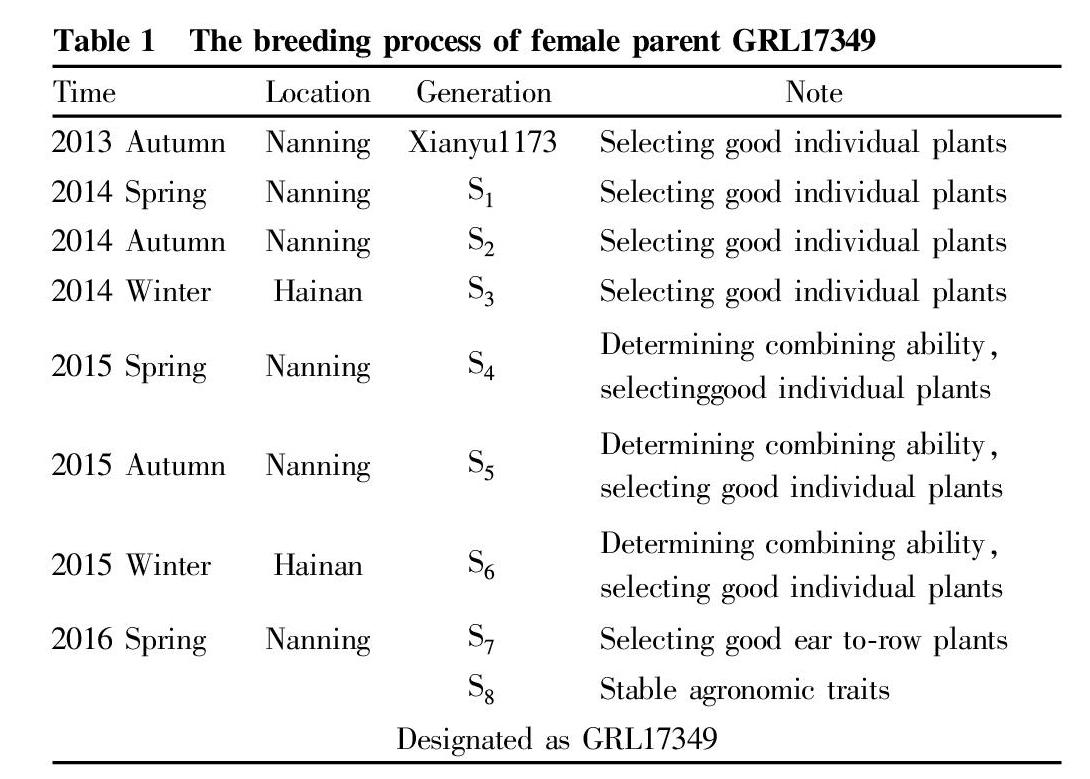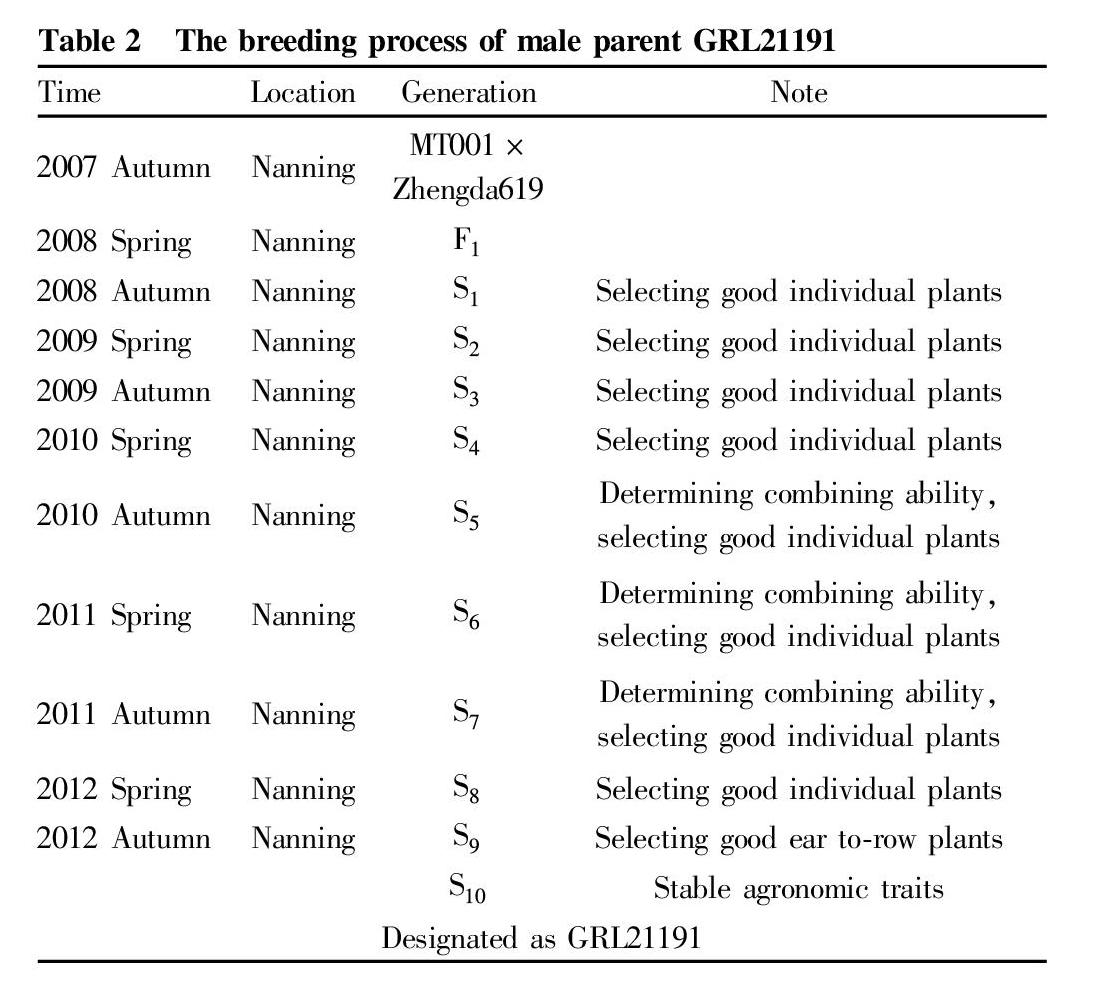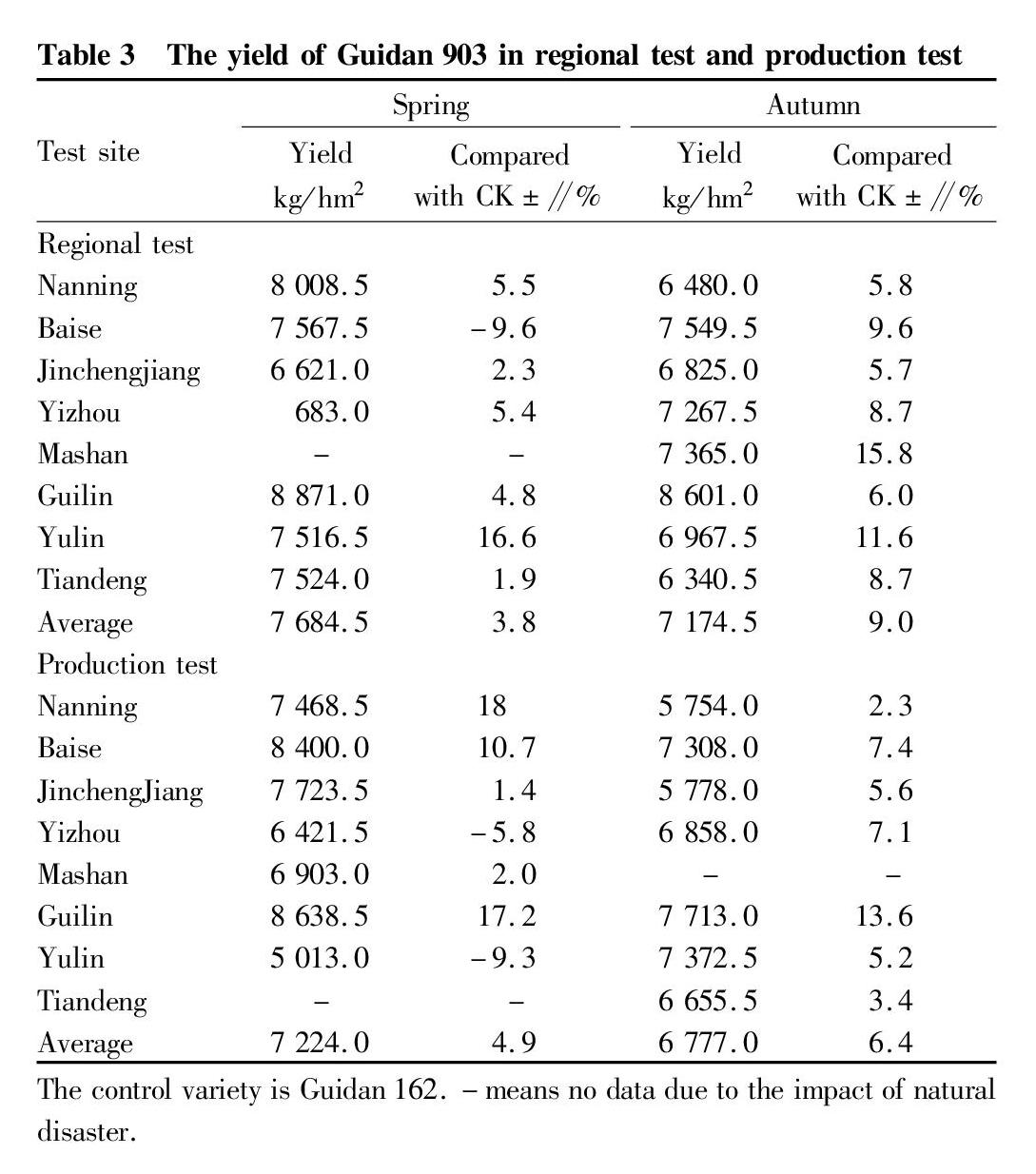Breeding and Application of Guidan 903, a New High-yield and Good-quality Maize Variety
2021-11-02JinguoZHOUXiaodongXIEHaiyuZHOUYufengJIANGLanqiuQINHexiaXIEZhaoleiTANGWeidongCHENG
Jinguo ZHOU Xiaodong XIE Haiyu ZHOU Yufeng JIANG Lanqiu QIN Hexia XIE Zhaolei TANG Weidong CHENG



Abstract To meet the demand of maize production in Guangxi and even the southwest region of China and realize the upgrading and undating of maize varieties which will continuously improve the yield and quality of maize, a new big-ear maize variety Guidan 903 with high yield, stable yield and good quality was established by the Maize Research Institute of Guangxi Academy of Agricultural Sciences with two self-selected inbred line GRL17349 and GRL21191 as female and male parents seperately.The average yield of this variety were 7 429.5 and 7 000.5 kg/hm2 in Guangxi Maize Regional Trial and Production Test respectively,which increased by 6.3% and 5.6% than the control (Guidan162). It was approved by Guangxi Zhuang Autonomous Region Crop Variety Certification Committee in June 2020(Approval No.Gui sheng yu 2020083). Determined by the Cereal Quality Supervision and Testing Center of Ministry of Agriculture and Rural Affairs (Bejjing), the grain bulk density,ratio of crude protein,crude fat,crude starch and lysine of Guidan 903 were 782 g/L, 9.41%, 6.19%, 71.45%, 0.35% respectively. This variety has the characterisics of strong resistance to collapse and disease, good quality, high and stable yield and wide adaptability.Furthermore,its seed yield is high with easy production technology and low cost.
Key words Maize; New variety; Guidan 903; Breeding; Seed production technology; Cultivation
Received: June 9, 2021 Accepted: August 10, 2021
Supported by Special Fund for Basal Scientific Research of Guangxi Academy of Agricultural Sciences (GNK 2021YT017, GNK 2017YM08); Science and Technology Development Fund of Maize Research Institute, Guangxi Academy of Agricultural Sciences (GYK 2017010); Natural Science Foundation Project of Guangxi (2018JJB130196).
Jinguo ZHOU (1975-), male, P. R. China, assistant research fellow, devoted to research about maize genetics and breeding and maize germplasm resources.
*Corresponding author. E-mail: 2108245844@qq.com.
Maize is Chinas largest food crop, and it is also an important economic crop and forage crop, which plays an important role in guaranteeing Chinas food security and industrial development[1-2]. Maize is the second largest food crop in Guangxi next to rice, with an annual planting area of about 600 000 hm2. Guangxi is in 20°54′-26°24′ N. latitude and 104°26′-112°04′ E. longitude, which belongs to central southern Asia tropical monsoon climatic region, the central section of which was traversesed by the tropic of Cancer and geomorphological type of which is mainly mountainous region and hills.With warm weather,high precipitation,obvious alternation of drying and wetting, Guangxi is one of rare two crop one year maize-planting zone in China.Due to the complex climate, soil and environmental conditions and the obvious regional microclimate in Guangxi, it is necessary to promote more than 10 maize hybrids to meet the needs of maize production in various places of Guangxi.At present, maize varieties promoted and planted in Guangxi mainly include Guidan 0810, Guidan 162, Guidan 166, Guidan 0811, Zhaofeng 505, Zhengda 808, Zhengda 719, Jiafu 399, Xianda 901, Sanbei 907, Youyu 909, Hengyu 821, Yahang 670, etc. With the continuous influx of foreign varieties and changes in the agricultural ecological environment, the occurrence of maize stalk rot, ear rot and grey speck disease in Guangxi has increased year by year, and new high-yield, high-quality and disease-resistant maize varieties have an even more urgent need for maize production in this region.With high yield, good quality, multiple resistance and special adaptability as the breeding objective for Guangxi as the special maize ecological zone, by applying the breeding method based on tropical germplasms supplemented by temperate germplasms[6], while paying attention to the improvement and utilization of foreign excellent maize germplasms[7], Maize Research Institute of Guangxi Academy of Agricultural Sciences bred a new maize variety, Guidan 903 in 2020 (GSY No.2020083).With the of high yield, wide adaptability, excellent quality and good resistance, this variety is suitable for popularization and planting in Guangxi.
Breeding Process
Breeding and characteristics of female parent GRL17349
GRL17349 is an inbred line bred in 2016 by Maize Research Institute, Guangxi Academy of Agricultural Sciences with continuously selecting excellent individual plants from the basic material Xianyu 1173, a hybrid of American Vanguard Corporationin in the process of 8 generations of selfing from the fall of 2013(see Table 1 for the breeding process). The inbred line was sown in Guangxi with a growth period of 123 d in spring and 110 d in autumn. Leaf sheaths of seedlings are light purple; the tip of the first leaf is round; the edge of the fourth leaf of the seedlings is green; each plant has 19-20 leaves; and the leaves lower than the panicles are flat, and those higher than the panicles are more upright. The "Z" shape of stems is weak, and the plant height is about 187.8 cm. Ears are about 70.5 cm high, and grow on the 7th to 8th penultimate leaves. Male tassels are about 36.2 cm, and have 3 to 5 branches. Anthers are light yellow, and the glume base and sterile lemma are green. Corn silk is light green, and male tassels and corn silk are coordinated. Ears are cone-shaped, about 13.8 cm long, about 4.1 cm in diameter, and the number of ear rows is 14-18. The seedrate is 75.6%, and the 1 000-grain weight is about 281 g. Grains are yellow and hard. Cobs are white. It is moderately resistant to southern rust disease. The general reproductive yield is about 4 500 kg/hm2.
Breeding and characteristics of male parent GRL21191
GRL21191 is an inbred line bred in 2012 by Maize Research Institute, Guangxi Academy of Agricultural Sciences with continuously selecting excellent individual plants from the double cross hybrid of American Monsanto maize hybrid MT001 and maize hybrid Zhengda619 in the process of 10 generations of selfing from the fall of 2007 according to the pedigree method (see Table 2 for the breeding process). The inbred line was sown in Guangxi with a growth period of 125 d in spring and 113 d in autumn. Seedlings grow well. Leaf sheaths are dark purple; the edge of the fourth leaf of each seedling is purple-red; and the number of leaves in adult plants is 20-21 leaves. The "Z" shape of stems is weak, and the plant height is about 234.6 cm. The ear height is about 106.3 cm. The plant shape is semi-compact. Male flowers are developed, and tassels have a length of about 36.7 cm, and 9-13 branches. The amount of pollen is large, and anthers are full. The base of glumes is light purple, and glumes are green. Corn silk is purple-red, and female ears begin to spin 2 to 3 d after male flowers disperse pollen. Ears grow on the 7th penultimate leaves.Ears are cylindrical, and have a length of about 12.5 cm, an ear thickness of about 4.7 cm, and the number of ear rows is 16-18. The seed yield is 75.3%, and the 1 000-grain weight is 263 g. Grains are yellow, of the hard-grain type, and cobs are white. It is resistant to southern corn rust, sheath blight, and northern and southern leaf blight. The general reproductive yield is 3 800 kg/hm2.
Breeding of Guidan 903
In the spring of 2016,inbred lines GRL17349 and GRL21191 were used as the female and male parents seperately to prepare a hybrid combination. In the autumn of 2016, the yield of the hybrid reached 10 281.0 kg/hm2 in the yield comparison experiment performed in the Mingyang Base of Guangxi Academy of Agricultural Sciences, which increased by 12% comparing with the control (Guidan 162). In the spring and autumn of 2017, the hybrid participated in the new maize combinations off-site identification test of Maize Research Institute, Guangxi Academy of Agricultural Sciences.The resistance and yield performance of the hybrid were outstanding, and the yield was higher than the control in all test sites including Nanning, Guigang, Yizhou, Mashan, Bama, Baise, and Jingxi.From 2018 to 2019, It participated in the regional trial and production test of the Guangxi Common Maize Scientific Research Consortium and reached the standard of Guangxi Maize Regional Trial.It was approved by the Crop Variety Approval Committee of Guangxi Zhuang Autonomous Region in June 2020 (Approval number: GSY No.2020083).
Yield Performance
Maize Regional Trial
The average yield of Guidan 903 in 2018 spring was 7 684.5 kg/hm2, which increased by 3.8% comparing with the control (Guidan 162).the yield increased in 6 sites out of 7 comparing with the control, which accounted for 85.71% of test sites. The average yield of Guidan 903 in 2018 autumn was 7 174.5 kg/hm2, which increased by 9.0% comparing with the control (Guidan 162).the yield increased in all 8 sites comparing with the control, which accounted for 100.00% of test sites.The average yield in spring and autumn was 7 429.5 kg/hm2, which increased by 6.3% comparing with the control.The percentage of yield-increasing sites was 93.33% (Table 3).
Production test
The average yield of Guidan 903 in 2019 spring was 7 224.0 kg/hm2, which increased by 4.9% comparing with the control (Guidan 162). The yield increased in 5 sites out of 7 comparing with the control, which accounted for 71.4% of test sites. The average yield of Guidan 903 in 2018 autumn was 6 777.0 kg/hm2, which increased by 6.4% comparing with the control (Guidan 162). The yield increased in all 7 sites comparing with the control, which accounted for 100.00% of test sites.The average yield in spring and autumn was 7 000.5 kg/hm2, which increased by 5.6% comparing with the control.The percentage of yield-increasing site was 85.71% (Table 3).
Jinguo ZHOU et al. Breeding and Application of Guidan 903, a New High-yield and Good-quality Maize Variety
Main Characteristics
Agronomic and economic traits
The new maize variety Guidan 903 with high-yield and high-quality has a growth period of 107 d in spring and 103 d in autumn in Guangxi.The color of bud sheath is purple, and the edge of the fourth expanded leaf of each seedling is light purple. The number of leaves in the whole growth period is 19-20. The plant type is open and flat, and the degree of "Z" stem is little or very weak. The plant height is 281.8 cm, and the ear height is 116.2 cm. Tassels have a length of 42 cm, and the number of first-level branches of tassels is 9-11. The color of anthers is light purple. The base of glumes is green, and glumes are light purple. Filaments are purple. The angle between ears and the stalk is less than 45°. Ears are cylindrical and have yellow and hard grains, and cobs are white. The ears have a length of 18.4 cm, a ear thickness of 5.3 cm, and a bald length of 1.9 cm. The ear row width is 14-22 rows, the average number of grains in rows is 34.3 grains, and the grain weight per ear is 143.5 g. The daily yield is 4.7 kg, the 1 000-grain weight is 336 g, and the seed yield rate is 79.1%. The empty stalk rate is 1.1%, and the double-ear rate is 0.5%.
Disease resistance
From 2018 to 2019, the two-year four-season disease resistance inoculation identification for Guidan 903 was carried out by Institute of Plant Protection, Guangxi Academy of Agricultural Sciences. The results showed that Guidan 903 has high resistance (HR) to stem rot, with an incidence rate of 4.9%, moderate resistance (MR) to sheath blight, with a disease index of 59.0, resistance (R) to southern rust, and it is susceptible (S) to large northern leaf blight and southern leaf blight, and susceptible (S) to Fusarium ear rot with an average disease grade of 6.3.
Lodging resistance
In 2018 Maize Regional Trial, the average lodging rate of spring and autumn was 4.4% ,the inversion rate is 0.0%,the sum of lodging and inversion rates is 4.4%, and the proportion of test sites with the sum of lodging and inversion rates ≥ 12% was 0.0%. In 2019 production test, the average lodging rate of spring and autumn was 2.0%, ranging from 0.0 to 8.0%, the average inversion rate was 0.6%,ranging from .0 to 4.6%,the sum of lodging and inversion rates was 2.6,%and the sum of lodging and inversion rates was 2.6%, the proportion of test sites with the sum of lodging and inversion rates ≥ 12% was 0.0%.
Grain quality
According to the analysis result provided by the Cereal Quality Supervision, Inspection and Testing Center (Beijing) of the Ministry of Agriculture and Rural Affairs, Guidan 903 has a grain bulk weight of 782 g/L, crude protein 9.41%, crude fat 6.19%, crude starch 71.45%, and lysine 0.35%.
Supporting Seed Production Technology
Selection of seed production base
Fields with medium or above soil fertility, strong water and fertilizer retention capacity, and convenient drainage and irrigation can be selected as seed production bases. Seed production bases require isolation conditions, that is, no other maize can be planted within 500 m of the seed production or breeding fields to prevent mixing of pollen.
Sowing period and ratio between parental lines
Sowing can be done when the temperature is stable above 12 ℃. The male and female parents are sown at the same time, and the row ratio of male and female parents is 1∶6. The planting density is 60 000 plants/hm2.
Field management
Thinning and final singling should be carried out timely. Intertillage weeding and fertilization management are also necessary, and attention should be paid to the application of phosphorus and potassium fertilizer. The amounts of fertilizers can be determined according to the soil fertility status, and 750 kg/hm2 of compound fertilizer (N∶P∶K=15∶15∶15) is generally applied.
Ensuring seed purity
Rouging and removal of weak plants should be carried out in time. Rouging should be done once at the seedling stage, jointing stage and before and after tasseling respectively to remove plants with different morphological characteristics. When the female parent is tasseling, castration should be performed completely in time.
Seed harvesting
If the seeds of male parent are not needed, the male parent can be cut off after the male parents pollen dispersal is finished. If the male parent seeds are needed, all the male parent seeds should be harvested after maize matures and placed at an isolated place, and then the female parent seeds can be harvested. Harvesting, threshing and sun-drying should be performed in time after ear selection and impurity removal.
Key Points of High-yield Cultivation Techniques
Timely sowing and weed control
The period when the spring temperature is stable above 12 ℃ is the suitable sowing period for Guidan903. Generally, spring sowing in northern Guangxi is from late February to early March, and autumn sowing is from late July to early August. Spring sowing in central Guangxi and southern Guangxi is in early-to-mid February, and autumn sowing is in early-to-mid August. After sowing and covering the soil, the sealing herbicide acetochlor is sprayed on the soil surface in a mixture with water to prevent the growth of weeds.
Reasonable dense plantin
Sowing sowing can be done in drill or hole, and the suitable planting density is 45 000-52 500 plants/hm2.
Timely thinning and final singling
Thinning and final singling can be started at the stage of 5 to 6 leaves to remove diseased seedlings, weak and prominent seedlings and retain medium seedlings, so as to ensure that the seedlings are neat and uniform.
Scientific fertilization
When sowing, 22 500-30 000 kg/hm2 of decomposed farmyard manure or 225-300 kg/hm2 of compound fertilizer is applied as base fertilizer. During final singling at the stage of 5-6 leaves, the seedling fertilizer of urea at a rate of 75-90 kg/hm2 and compound fertilizer at a rate of 105-120 kg/hm2 is applied combined with loosening soil. At the big bell mouth period, the ear fertilizer is applied heavily with compound fertilizer at a rate of 300 kg/hm2 and urea at a rate of 225 kg/hm2, combining with soil cultivation to improve the lodging resistance of maize.
Strengthening field water management
Maize plants are not tolerant to waterlogging. After heavy rains, accumulated water in fields should be drained in time to avoid prolonged soaking. For maize, 10 d before tasseling to 20 d after blooming and pollen dispersing is the critical period of water demand, during which maize is the most sensitive to water response. In case of drought, it will cause severe yield reduction. Therefore, attention should be paid to irrigation and drought resistance during this period.
Paying attention to pest control
At the seedling stage, attention should be paid to the prevention and control of underground pests such as cutworms, Ostrinia nubilalis. At the big bell mouth stage, aphids before the dispersion of maize pollen and anthesis, and the harm of Spodoptera frugiperda should be observed and prevented during the entire growth period.
Suitable area for planting
Guidan903 is suitable for planting in the whole area of Guangxi.
References
[1] ZHAO JR, WANG RH, LIU XX. Current situation of maize industry and development trend of biological breeding in China[J]. Biotechnology & Business, 2016(3): 45-52. (in Chinese)
[2] ZHANG SH, XU WP, LI MS, et al. Challenge and opportunity in maize breeding program[J]. Journal of Maize Sciences, 2008, 16(6): 1-5. (in Chinese)
[3] LI SK, ZHAO JR, DONG ST, et al. Advances and prospects of maize cultivation in China[J]. Scientia Agricultura Sinica, 2017, 50(11): 1941-1959. (in Chinese)
[4] ZHAO JR, WANG S, LI M, et al. Current status and perspective of maize breeding[J]. Journal of Plant Genetic Resources, 2018, 19(3): 435-446. (in Chinese)
[5] HUANG CL, PAN CX. CIMMYT maize germplasm improvement strategy in the 21st century[J]. Journal of Maize Sciences, 1993(2): 16-17. (in Chinese)
[6] CHENG WD, QIN LQ, ZHOU JG, et al. Analysis of hybridization model of maize variety released in Guangxi[J]. Guangxi Agricultural Sciences, 2008(3): 393-396. (in Chinese)
[7] PAN XM, YAO WH, HUANG YX. Technical approaches to improve maize breeding efficiency[J]. Crops, 2007(2): 1-4. (in Chinese)
杂志排行
农业生物技术(英文版)的其它文章
- Effects of Pruning Methods on the Growth and Development of New Shoots and Fruit Yield and Quality of Walnut
- Selection of Grape Varieties Suitable for Double Cropping a Year in Northern Greenhouse
- Effects of Uniconazole on Photosynthetic Characteristics of Dahlia pinnata Cav. under Drought Stress
- Community Structure and Value Evaluation of Local Brassicaceae Potherbs in Shiyan City
- Home Planting Techniques of Green and Healthy Rape Sprouts
- Research Progress of Polygonatum Germplasm Resources in China
